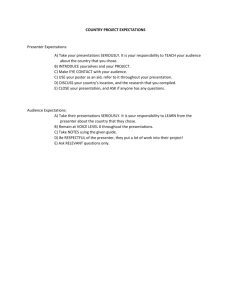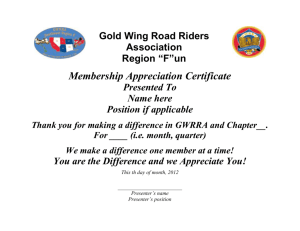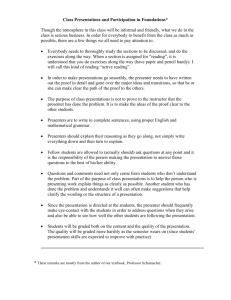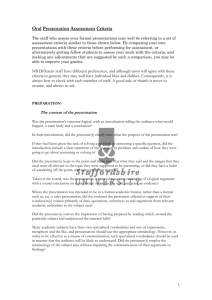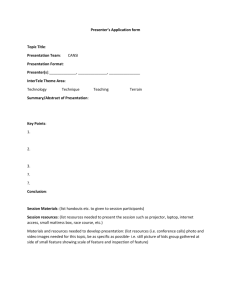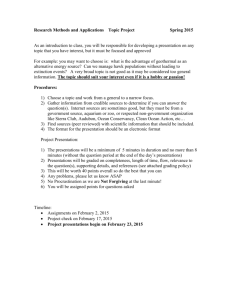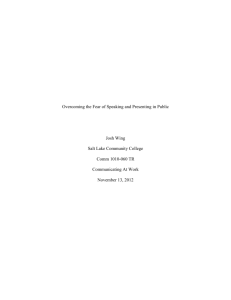The Art of Communicating Effectively
advertisement
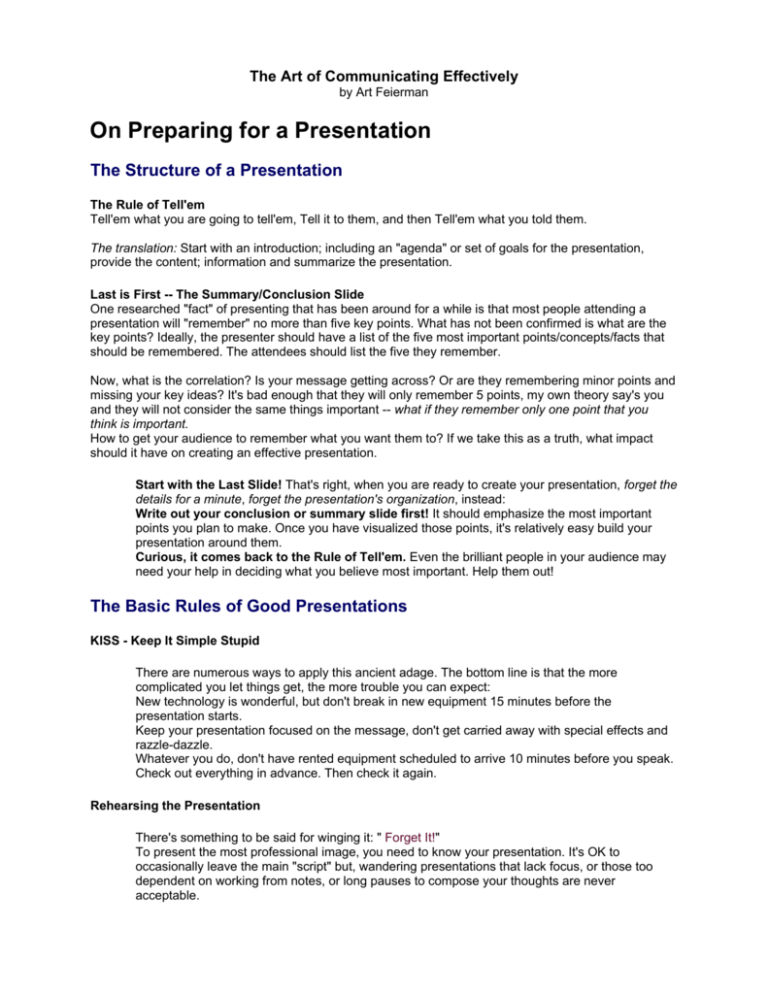
The Art of Communicating Effectively by Art Feierman On Preparing for a Presentation The Structure of a Presentation The Rule of Tell'em Tell'em what you are going to tell'em, Tell it to them, and then Tell'em what you told them. The translation: Start with an introduction; including an "agenda" or set of goals for the presentation, provide the content; information and summarize the presentation. Last is First -- The Summary/Conclusion Slide One researched "fact" of presenting that has been around for a while is that most people attending a presentation will "remember" no more than five key points. What has not been confirmed is what are the key points? Ideally, the presenter should have a list of the five most important points/concepts/facts that should be remembered. The attendees should list the five they remember. Now, what is the correlation? Is your message getting across? Or are they remembering minor points and missing your key ideas? It's bad enough that they will only remember 5 points, my own theory say's you and they will not consider the same things important -- what if they remember only one point that you think is important. How to get your audience to remember what you want them to? If we take this as a truth, what impact should it have on creating an effective presentation. Start with the Last Slide! That's right, when you are ready to create your presentation, forget the details for a minute, forget the presentation's organization, instead: Write out your conclusion or summary slide first! It should emphasize the most important points you plan to make. Once you have visualized those points, it's relatively easy build your presentation around them. Curious, it comes back to the Rule of Tell'em. Even the brilliant people in your audience may need your help in deciding what you believe most important. Help them out! The Basic Rules of Good Presentations KISS - Keep It Simple Stupid There are numerous ways to apply this ancient adage. The bottom line is that the more complicated you let things get, the more trouble you can expect: New technology is wonderful, but don't break in new equipment 15 minutes before the presentation starts. Keep your presentation focused on the message, don't get carried away with special effects and razzle-dazzle. Whatever you do, don't have rented equipment scheduled to arrive 10 minutes before you speak. Check out everything in advance. Then check it again. Rehearsing the Presentation There's something to be said for winging it: " Forget It!" To present the most professional image, you need to know your presentation. It's OK to occasionally leave the main "script" but, wandering presentations that lack focus, or those too dependent on working from notes, or long pauses to compose your thoughts are never acceptable. Rehearsing the presentation includes more than just going over what you will be saying. Rehearsing includes the entire presentation. Use the same tools too. If you are using slides, or a projector, and have access to the room you will be presenting in, rehearse there. Using a remote mouse and laser pointer for the presentation, a microphone? Rehearse the presentation with these devices. Don't memorize Rehearsing is one thing, committing the presentation to memory and performing it by heart, is not the way to go. You need to present, not to recite. But use your notes very sparingly. Too much time spent reading notes may convince your audience that you are unprepared. Dress for success. Some say you can never overdress for a presentation. Others will disagree. Our own belief is that other factors come in to play, particularly how you handle yourself in the situation. Humor and how formal your presentation is will impact whether you are "over" presented. But everyone agrees you should never underdress. How to determine what is appropriate? Worst case: Ask people. It's all part of doing it right. Pace yourself - don't go too fast, or too slow. A general rule, every "slide" deserves at least 10 seconds, and none rate more than 100. If you find yourself spending several minutes on one slide, consider breaking it up! (We're not suggesting this as a firm rule, but a good guideline. Obviously, some charts or graphics may take several minutes to properly present.) Then again, perhaps they could be better as multiple "slides." If you are done with a "slide" - lose it. Don't leave an image up for your audience once you move on to other points. The Presentation Tools Slides, LCD and DLP Projectors, Laptops, LCD panels, Video, Multimedia, Sound. Laser Pointers, Lapel Microphones, Overheads, Photo-quality printers, Posterprinters... There are a great many presentation tools available to you as a presenter. Determine your communication needs, the presentation environment, and select the right group of tools to get your message across. Creating Support Materials Great, you have put together the killer presentation of all time. You looked good, your audience reacted positively. It couldn't have gone better, so what's wrong? Several attendees return to their organizations. They go to brief their superior, after two questions, it becomes apparent that they have the concept. Unfortunately, it also becomes apparent that they don't have any specifics. Why? No or poor documentation/handouts. When all the other pieces of the puzzle are in place, don't limit the staying power of your message, by providing it without the right support materials. It is Time to Speak Out -- Giving an Effective Presentation On Fear and Death The Naked Audience It's been said that most people, including a great many executives, fear presenting to large groups even more than they fear death. If you are that nervous going into a presentation, one old technique we've heard before: Get out there, look around, close your eyes for a moment, and picture the people in the front row, either naked or in their underwear (depending on your moral fibre). Either way, it is said to have a relaxing, almost humorous effect. The person who said "there is nothing to fear, but fear itself" has never had his computer crash in mid presentation, his overheads all fall on the floor, her slide tray still be in the overhead compartment.... Pick one (or two) people easily visible to you, and "speak" to them. Oh, be sure to also observe others, but concentrate on just a few. This may or may not solve your "audiencophobia" but it will keep you in touch with your audience, and provide you with some feedback. Your place as a Presenter Controlling your Audience, not your computer • • • • Face your audience Observe them Make eye contact - don't wander around the room, don't look down. Wandering can be a sign of nervousness, while looking down, may be taken as "trying to figure out what's next". (Remember - you're the speaker -- you're supposed to know. Lose the computer -- that is -- don't hide behind it. Get a remote mouse and get back up in front of the group, where you belong, as presenter, leader, moderator, and communicator. Deferring questions, following up Depending on the nature of the meeting you are presenting at, it may be appropriate to field questions during the presentation. In some cases it will be proper to answer the question on the spot, in other cases, you may be addressing that point later, or want to cover it later on or after the meeting. You are the best judge of how to handle it. Retain control of the flow of the presentation. Where appropriate defer questions to later in the presentation or afterwards. It is perfectly acceptable to reply with: "I would like to address your question later on when I cover..." or "You and I can discuss that after the conclusion of the presentation..." or "Regretfully, I do not have that information readily available. Please meet me after the meeting, I will get your name... and get back to you next week." If you do defer any questions: Follow through as promised. Nothing will damage your credibility in the long run, more than not keeping your word. Measuring your audience Hint: Snoring is a really bad sign! We have suggested you focus on only a few people in your audience. Are they attentive? What about body language -- are they fidgeting or checking their watches? Taking notes? Taking naps? Seriously, it is for you to take note as to which parts of your presentation are having an impact, and which are lost on your listeners. Technology soothes the beast It's the Nineties, do you have a laptop and projector. In the last couple of years presentation products have made tremendous strides. For example, today's projectors have evolved at least as much in the past two years, as computers have done in the last five. With the big improvements in capabilities, everyone expects more of you and your presentation. As we have said elsewhere, the changes are rapid, so Lead, Follow, or Get out of the Game. "They thought my slides were great last time (1988)" Presentations: The State of Confusion or "the presentation isn't till tomorrow" "I have trouble sleeping on the plane, with a PC on my lap." Simply put: DON'T WAIT TILL THE VERY LAST MINUTE TO WORK ON YOUR PRESENTATION. We all know that few presentations are really finished and "in the can" even a couple of days before the presentation must go on. That's even with best intentions. Get an early start on your presentation. You will still be changing it at the last minute regardless. It's the knowledge stupid, not the graphics This is probably a corollary of KISS: The purpose of your presentation is to communicate ideas and information, not to dazzle people with fancy graphics. When the session is over, you want your audience marching out discussing the ideas you set forth, not talking about the neat graphics, the special effects, etc. Your Presentation Achieves Consciousness: or How to Make an Impression. Alternative: Your audience achieves unconsciousness If you had to do it again, and again You have the content worked out, you followed all the rules, everything you must have in the presentation -- direction, focus, information, reinforcement is there. Now what will make it even better?: Enthusiasm -- Absolutely nothing will help your presentation more than communicating your passion and confidence. It doesn't have to be an evangelical "Do you BELIEVE -- I BELIEVE," but the audience will recognize your belief, and confidence, and it will add credibility to your message. The Power of Language The words you select will dramatically impact your audiences reaction -- to both your ideas and your effectiveness as a presenter. Your word processor has a thesaurus -- learn to use it -- effectively. Use "power" and "command" words to get your audiences attention and to give the impression of confidence and competence. A few examples: Instead of "I think you will agree" try "I am certain you will agree" I hope you will consider vs. I recommend you to consider. Address your audience in second person. "You" is a very powerful word, generally audiences react much better to being addressed as "you" than in the third person as they. "As a participant, you will benefit" vs. Participants will benefit. Not only should you put a thesaurus to work to find "better" words with more impact, but also to prevent excessive use of the same word over and over again. (Throughout this web site we have suffered from excessive use of the words need, requirement, and solution, even with the thesaurus, we enjoyed little relief, but still we probably reduced the use of "need" be 50%. Other than that, "requirement" and "requisite" make a more powerful impact. Humor The right amount of humor - used judiciously, can go a long way to build rapport with your audience, and keep your audience interested and attentive. As a rule, don't tell jokes for their own sake, drop in your humor where it fits, relating to a point, or a break between sections. Small amounts of humor or a irreverent comment from time to time can go a long way to liven a presentation. Remember, a sleeping audience remembers little. Don't push your luck! Rehearsing your presentation in front of real people is a great way to test the "acceptability" of your humor. Quotations Appropriate quotations can make a noticeable impact on your audience. It's not always possible to find quotes that are directly relevant to your presentation, but it is often easy to find a series of quotes that complement or promote concepts that are part of your presentation. One presenter I know, in the Multi-level marketing business, likes to put a series of quotes from computer "visionaries" including Thomas Watson (IBM), Ken Olson (DEC), Bill Gates (Microsoft)...in his presentations. These quotes go back many years: • • • Thomas Watson (former Chairman of IBM, didn't think computers would ever be popular. Ken Olson (founder and former president o DEC) couldn't figure out why anyone would want a computer at home. Bill Gates thought that 640K of memory would be enough for everyone. With the less than stellar credibility much of multi-level marketing is perceived to have, these quotes which are all "way off the mark" provide a cautionary tale that tells you that perceptions are not always right. Better still, after the first couple of quotes, the audience is "looking" for more -- they are having an impact on the audience. Bottom line: Make your Quotations relevant -- and interesting! What is the difference between your audience and an elephant? The elephant never forgets -- the audience occasionally remembers! Art's Rule of Five (Five presentation reminders in five categories) Five things to do: Rehearse 1. When rehearsing before a live being, eliminate your overview and summary slide. Find out what they found interesting, memorable, confusing. Have them list what they thought was most important! Did they get your message? 2. Test all your equipment in advance of the presentation. 3. Rehearse using as much or all of the tools you plan use during the real thing. 4. Have a backup plan: What if your projector dies, computer crashes, slide tray still on the plane. What is plan B. (And did you practice it?) 5. Introduction, Objective, Overview, Presentation, Summary (Conclusion) Five things for your audience to do 1. 2. 3. 4. 5. Stay awake. Receive the information they seek. Get your message. Take away supporting materials that help them disseminate the information you presented. Act on your information. Five things to do when you are done 1. 2. 3. 4. 5. Thank them! Make materials available Make yourself available Provide them with a method of reaching you Get feedback -- Find out what they thought of you, what they learned, what they were hoping to learn but didn't, how you can improve your presentation, how to improve your communication skills. 10 Little-Known, Rarely Discussed, Highly Effective Presentation Techniques by Marjorie Brody 1) Know Your PAL™ (Before preparing any presentation for one person or thousands, know your Purpose (inform, persuade, entertain), know your Audience (demographics, attitudes, hot buttons), and know your Logistics (Time allotment, number of people in the audience, time of day for presentation, room arrangements). 2) Pay Attention to Timing -- A good strategy for a straight presentation is to plan, prepare and practice for 75% of the allotted time. If you end early, no one complains. Ending late is poor planning. If you expect audience involvement, plan on 50% of the time and 25% for interactive facilitated sessions. 3) All presentation material is not created equal. When preparing your speech, consider the must know, should know, could know. Limit material based on time or audience interest. 4) Hitting the emotional buttons will create more impact and action than pure data. Include stories, analogies, metaphors to reinforce the key points. 5) Create user friendly notes. As Winston Churchill said when he was asked why he carried notes but seldom used them, "I carry fire insurance, but I don't expect my house to burn down." Use bulleted points instead of sentences. Make the type easy to read (use felt tip pen or minimum 18 point type, boldface, if typed), only use the top 2/3 of the page to avoid looking down, use highlight pens to indicate the must/should/could know information. 6) Practice out loud saying it differently each time you say it. Peter Drucker says, "Spontaneity is an infinite number of rehearsed possibilities." Doesn't Tiger Woods still practice? 7) Stage fright is a negative term for excitement. No coach tells the team to be calm. Channel the adrenaline into enthusiasm. You can control the physical symptoms by breathing from the diaphragm, positive visualization and self talk, plus by being prepared and practiced. 8) Deliver with passion, it's amazing how catchy enthusiasm is. If your voice is expressive and your gestures animated you will appear to be confident and passionate. 9) The question and answer part of the presentation may be more important than the actual presentation. Think ahead to all possible questions that might be asked -- particularly the ones that might throw you. Remember to paraphrase the questions before answering them and take into account the motivation of the questioner. When answering the questions look at all audience members - they may have had the same question. Avoid complementing some questions and not others. Treat all questions and questioners with respect. 10) Remember -- speaking is an audience-centered sport. Avoid speaking out of ego, appearing too cocky or unprepared. As long as you stay focused on the audience -- in preparation, delivery and during the Q and A, you should be successful as a presenter.
